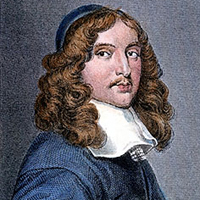The Coronet by Andrew Marvell: Summary and Analysis
Marvell's The Coronet appeals for maintaining the faith upon god and urges to contemplate the deeds of narrow minded belief of putting the crown of thorns on Jesus Christ. A shepherd is a speaker of a poem who wants to gather different flowers from different gardens to weave and make a new crown to glorify his Saviour; Jesus Christ and correct the unfair action replacing by the beautiful flowery crown that no king has yet worn.

Andrew Marvell (1621-1678)
The speaker’s religious belief is reflected when he uses the allusion of thorn that Christ wore during the time of the crucifixion and wants to replace with the crown of beautiful flowers. However, he realized that his thought of making a new crown is affected by the deceitful serpent, or Satan disguised among the flowers. In this sense the divine quality of Christ is not yet justified, though the speaker who wanted to redress the wronged deeds of innocent commoners however, they are influenced by greed and lust represented by the serpent; a revolutionary angel similar found in the Eden of gardens.
The speaker of the poem surveys the history of Christianity and thinks about parochial people who couldn’t understand and recognize Jesus Christ. Instead of lamenting for the past the speaker produces creative writing as the chief means of justifying Christ’s divinely qualities. Making a garland of flowers is a metaphor for creativity designed to glorify God. It might be noted that gathering flowers are associated with the act of writing poetry. By negating the deeds of commoners the speaker has produced a poem that advocates the Christ’s divinity virtues. The activities of the people who offered thorny garland to the Christ saddened the speaker thinking that parochial people could not identify “the savior”/ Christ. Finally, he composes a poem to justify the divine quality of Christ.
The poem is composed in meditative mode of expression. The formal devices like alliteration, assonance, domination of harsh sounds, parenthesis, and archaic use of words, images and iambic pentameter are used in the poem. Some visual images like, head, crown, mead, king, serpent, etc. can also be found in the poem. The poet has also used parenthesis in two places: (my fruits are only flowers) and (so I myself deceive). Moreover, the farfetched comparison between serpent and narrow-minded people gives rise to conceit. There are some distinctive formal features of the poem. “The Coronet” implicitly valorizes the divine existence of Christ.
The poem is cavalier that supports, the king’s crown and court. The poem is related to biblical theme which favors the religion and Jesus Christ. The speaker of the poem has faith in God and his power thus it is traditional in a sense that God is believed as king and the king’s power as a crown. The speaker of the poem doesn’t like enemy of the king and favors the glory of the court. So this poem is about the favor of Charles I and his state. The speaker scolds the serpent (people) who are against the glory of kingdom in the poem. The poem is cavalier in the sense that it is written in witty and policed language too.
Related Topics
The Garden: Summary and Analysis
To His Coy Mistress: Summary and Analysis
The Definition of Love: Summary and Analysis
 |
bachelorandmaster.com |